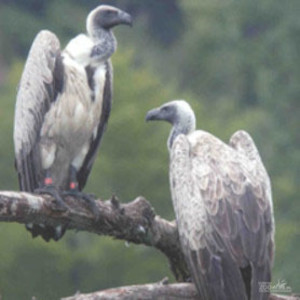African White-Backed Vulture
[Gyps africanus]

This African White-Backed vulture has a bare head and sparse yellowish or whitish down on the back of the neck. Length is about 3 feet, and weight about 12 pounds. The wingspan is over 7 feet. This bird cannot fly far without using thermals to permit long glides. It often flies over 30 miles to find food. It often perches near cattle kraals, where it expects dead livestock to be available. Because its bill is weak, it must feed on the innards and soft flesh of the animal after hyenas or jackals have opened up the carcass. The bird is quite gregarious at feeding sites and at its roost in tall trees, making throaty squawks, hisses, and pig-like squeals. They roost in groups until two or three hours after dawn, and return to the roost about three hours before dark. They often gorge themselves until they are too full to fly. Breeding takes place from August to April. They may make their own nests of sticks and leaves held together by guano, or they take over old nests of storks, eagles or secretary birds. Both male and female share in the incubation of the single egg, and in caring for the chick until it can fly at about six weeks of age. They will not breed if food is scarce.
Location: African Savanna
Share:
Range
The range of the African White-Backed vulture is Tropical Africa.
Habitat
African White-Backed vultures inhabit savannas, grasslands, sub-desert; sometimes in dense woodlands with abundant rainfall.
Conservation Status
EndangeredPrimary Threats
Human Wildlife Coexistence, Climate ChangeGestation
Incubation: 56 to 58 days
Litter
1 egg
Behavior
African White-Backed vultures cannot fly far without using thermals to permit long glides. It often flies over 30 miles to find food. It often perches near cattle kraals, where it expects dead livestock to be available. Because its bill is weak it must feed on the innards and soft flesh of the animal after hyenas or jackals have opened up the carcass. The bird is quite gregarious at feeding sites and at its roost in tall trees, making throaty squawks, hisses, and pig-like squeals. They roost in groups until two or three hours after dawn, and return to the roost about three hours before dark. They often gorge themselves until they are too full to fly.
Reproduction
African White-Backed vultures breed in loose groups, often in arid areas and nests in tall trees. The nuptial display is not spectacular, and consists mostly of slow circling in pairs near the nest. Copulation takes place in the trees or in the nest itself. Breeding takes place from August to April. They may make their own nests of sticks and leaves held together by guano, or they take over old nests of storks, eagles or secretary birds. The nests are comparatively small for the size of the bird. Both male and female share in the incubation of the single egg and in caring for the chick until it can fly at about six weeks of age. They will not breed if food is scarce.
Wild Diet
Carrion - dead wild animals and domestic stock; bone flakes
Zoo Diet
Meat and bone chips
